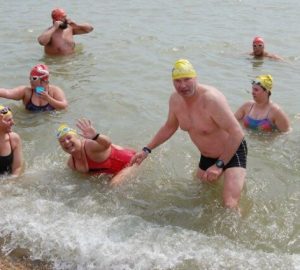How safe does it have to be before we can swim?
It’s been another frustrating weekend for open water swimmers in the UK (following, a frustrating spring and early summer). In Cumbria, the Great North Swim, scheduled to take place in Windermere, was cancelled because “strong winds affect the ability of the safety kayakers to operate and also may make swimming conditions extremely challenging,” according to the organisers.
Nor did the more sheltered south of the country escape. The Environment Agency (EA) put up amber warning boards on the Thames on Saturday afternoon and advised against the use of unpowered craft. This ended the famous Henley Classic as the safety providers would not put their kayaks on the water against EA advice.
These are just two examples of an on-going trend. The Great East Swim was also postponed and the Wales Swim shortened recently.
For event organisers, cancelling, curtailing or postponing events, especially at the last minute, is a nightmare. It’s costly and often provokes angry reactions from swimmers, either because they felt they should have been informed earlier or they disagree with the safety assessment.
The latter point is especially relevant. Unfortunately though there are very few agreed safety standard and lots of variables – water temperature, air temperature, currents, wave height, wind speed and direction, visibility and swimmer experience and capability. Then there has to be an element of forecasting – how might the conditions change during the event? This means discussions about whether it’s safe to swim can turn into subjective “yes it is, no it isn’t” affairs. And the one who says, “no it isn’t” has the moral high-ground if anything goes wrong, so that’s the option we take most easily.Some swimmers relish the opportunity to test themselves in tough environments and so are especially annoyed when events are cancelled in conditions they’re confident they can cope with. For these swimmers, tough conditions add to the excitement and challenge and make the event all the more worth doing.
Sometimes swimmers need to deal with rough conditions
Event organisers however have to think about all their participants. We recently spoke to someone involved in the safety management at open water and other extreme events, who said something along the lines of:
“When you consider safety, your main concern isn’t the people at the front of the pack who’ve done multiple swims but those who may never have swum in open water before, have turned up with a brand new wetsuit three sizes too big, and for whom swimming a mile in open water is the toughest physical challenge they’ve undertaken in 10 years, if not their life. A strong freestyle swimmer may power through the chop, while a slow breast stroke swimmer will be smacked in the face by every wave.”
This creates a tension within the industry. If events can only take place under the most benign conditions we will see many more cancellations. This in turn will discourage people from entering (or at least postponing their entries until the last minute) and make it harder of organisers to profit from events, which they need to in order to sustain the sport. Meanwhile, those looking for more excitement may seek their thrills elsewhere, most likely under less supervision, hence putting themselves at great risk.
On the other hand, if we allow events to go ahead whatever the conditions, people will get hurt, or worse.
One possible way forward will be for swimmers to take more responsibility for managing their own safety. We have to recognise that no open water event will ever be entirely risk free. This message should be made loudly and often to encourage swimmers to be more alert to the dangers both to themselves and those around them. Then we have to acknowledge that some swims incur more risks than others: non-wetsuit rough cold sea swims are more dangerous (and, some would say, more fun) than wetsuited swims in warm, calm, shallow lakes. If these differences are made clearer to participants, then a degree of self-selection can take place, and swimmers would start preparing themselves according to the conditions they expect to face.
As societies, we accept some kinds of risk much more readily than others. We allow people to drink alcohol, smoke and drive motorbikes. So why not let them swim in tough conditions? We don’t ban people from driving when roads are wet or icy or when visibility is reduced to a few metres because of fog, but we do expect drivers to exercise caution. Can we then, take a more flexible approach to risk management in open water events?
Perhaps we could label swims on a scale of 1 to 5 where level one swims are suitable for all and level 5 swims are really tough. A swim could be billed at its expected level, but swimmers should be aware that the level could change on the day. The organisers will have an appropriate safety plan in place for the conditions, and swimmers could decide whether or not to continue based on their ability. Events will still be cancelled in extreme conditions but others, that are currently being curtailed, could go ahead.






